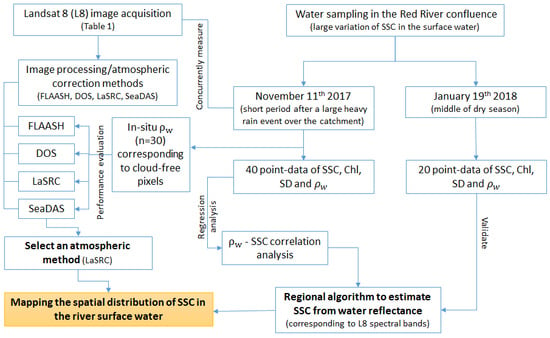Using Landsat-8 Images for Quantifying Suspended Sediment Concentration in Red River (Northern Vietnam)
Abstract
1. Introduction
2. Materials and Methods
2.1. Study Area
2.2. Field Sampling and Measurement
2.3. Image Analyses
3. Results
3.1. In Situ Radiometry and SSC
3.2. Evaluating of Landsat-Derived ρw for Monitoring SSC
3.3. Mapping SSC in the Red River Using L8SR
4. Discussion
5. Summary and Conclusions
Author Contributions
Funding
Acknowledgments
Conflicts of Interest
References
- Clesceri, L.S.; Greenberg, A.E.; Eaton, A.D. Standard Methods for the Examination of Water and Wastewater, 20th ed.; APHA American Public Health Association: Washington, DC, USA, 1998; 1220p. [Google Scholar]
- Edward, T.K.; Glysson, G.D.; Guy, H.P.; Norman, V.W. Field Methods for Measurement of Fluvial Sediment. Available online: https://pubs.er.usgs.gov/publication/ofr86531 (accessed on 29 September 2018).
- Ritchie, J.C.; Cooper, C.M. Comparison of measured suspended sediment concentrations with suspended sediment concentrations estimated from Landsat MSS data. Remote Sens. 1988, 9, 379–387. [Google Scholar] [CrossRef]
- Doxaran, D.; Froidefond, J.M.; Castaing, P. A reflectance band ratio used to estimate suspended matter concentrations in sediment-dominated coastal waters. Int. J. Remote Sens. 2002, 23, 5079–5085. [Google Scholar] [CrossRef]
- Wang, J.J.; Lu, X.X.; Liew, S.C.; Zhou, Y. Retrieval of suspended sediment concentrations in large turbid rivers using Landsat ETM+: An example from the Yangtze River, China. Earth Surf. Process. Landf. 2009, 34, 1082–1092. [Google Scholar] [CrossRef]
- Ritchie, J.C.; Schiebe, F.R.; Mchenry, J.R. Remote sensing of suspended sediments in surface waters. Photogramm. Eng. Remote Sens. 1976, 42, 1539–1545. [Google Scholar]
- Wu, J.L.; Ho, C.R.; Huang, C.C.; Srivastav, A.L.; Tzeng, J.H.; Lin, Y.T. Hyperspectral sensing for turbid water quality monitoring in freshwater rivers: Empirical relationship between reflectance and turbidity and total solids. Sensors 2014, 14, 22670–22688. [Google Scholar] [CrossRef] [PubMed]
- Fan, C. Spectral analysis of water reflectance for hyperspectral remote sensing of water quality in estuarine water. J. Geosci. Environ. Protect. 2014, 2, 19. [Google Scholar] [CrossRef]
- Sathyendranath, S. Remote Sensing of Ocean Colour in Coastal, and Other Optically-Complex, Waters. IOCCG Report Number 3, Dartmouth, Canada, 2000, 140p. Available online: http://www.ioccg.org/reports/report3.pdf (accessed on 9 November 2018).
- Doxaran, D.; Babin, M.; Leymarie, E. Near-infrared light scattering by particles in coastal waters. Opt. Express 2007, 15, 12834–12849. [Google Scholar] [CrossRef] [PubMed]
- Astoreca, R.; Doxaran, D.; Ruddick, K.; Rousseau, V.; Lancelot, C. Influence of suspended particle concentration, composition and size on the variability of inherent optical properties of the Southern North Sea. Cont. Shelf Res. 2012, 35, 117–128. [Google Scholar] [CrossRef]
- Milliman, J.D.; Meade, R.H. World-wide delivery of river sediment to the oceans. J. Geol. 1983, 91, 1–21. [Google Scholar] [CrossRef]
- Le, T.P.Q.; Garnier, J.; Gilles, B.; Sylvain, T.; Minh, C.V. The changing flow regime and sediment load of the Red River, Viet Nam. J. Hydrol. 2007, 334, 199–214. [Google Scholar] [CrossRef]
- Wang, J.J.; Lu, X.X. Estimation of suspended sediment concentrations using Terra MODIS: An example from the Lower Yangtze River, China. Sci. Total. Environ. 2010, 408, 1131–1138. [Google Scholar] [CrossRef] [PubMed]
- Espinoza Villar, R.; Martinez, J.M.; Texier, M.L.; Guyot, J.L.; Fraizy, P.; Meneses, P.R.; Oliveira, E. A study of sediment transport in the Madeira River, Brazil, using MODIS remote-sensing images. J. S. Am. Earth Sci. 2013, 44, 45–54. [Google Scholar] [CrossRef]
- Mangiarotti, S.; Martinez, J.M.; Bonnet, M.P.; Buarque, D.C.; Filizola, N.; Mazzega, P. Discharge and suspended sediment flux estimated along the mainstream of the Amazon and the Madeira Rivers (from in situ and MODIS Satellite Data). Int. J. Appl. Earth Obs. Geoinf. 2013, 21, 341–355. [Google Scholar] [CrossRef]
- Aranuvachapun, S.; Walling, D.E. Landsat-MSS radiance as a measure of suspended sediment in the lower Yellow River (Hwang Ho). Remote Sens. Environ. 1988, 25, 145–165. [Google Scholar] [CrossRef]
- Mertes, L.A.K.; Smith, M.O.; Adams, J.B. Estimating suspended sediment concentrations in surface waters of the Amazon River wetlands from Landsat images. Remote Sens. Environ. 1993, 43, 281–301. [Google Scholar] [CrossRef]
- Zhang, M.; Dong, Q.; Cui, T.; Xue, C.; Zhang, S. Suspended sediment monitoring and assessment for Yellow River Estuary from Landsat TM and ETM+ imagery. Remote Sens. Environ. 2014, 146, 136–147. [Google Scholar] [CrossRef]
- Montanher, O.C.; Novo, E.M.L.M.; Barbosa, C.C.F.; Renno, C.D.; Silva, T.S. Empirical models for estimating the suspended sediment concentration in Amazonian white water rivers using Landsat 5/TM. Int. J. Appl. Earth Obs. Geoinf. 2014, 29, 66–77. [Google Scholar] [CrossRef]
- Pereira, L.S.F.; Andes, L.C.; Cox, A.L.; Ghulam, A. Measuring suspended-sediment concentration and turbidity in the middle Mississippi and lower Missouri Rivers using Landsat data. J. Am. Water Resour. Assoc. 2018, 54, 440–450. [Google Scholar] [CrossRef]
- Gholizadeh, M.H.; Melesse, A.M.; Reddi, L. A comprehensive review on water quality parameters estimation using remote sensing techniques. Sensors 2016, 16, 1298. [Google Scholar] [CrossRef] [PubMed]
- Pahlevan, N.; Lee, Z.; Wei, J.; Schaaf, C.B.; Schott, J.R.; Berk, A. On-orbit radiometric characterization of OLI (Landsat-8) for applications in aquatic remote sensing. Remote Sens. Environ. 2014, 154, 272–284. [Google Scholar] [CrossRef]
- Zheng, Z.; Li, Y.; Guo, Y.; Xu, Y.; Liu, G.; Du, C. Landsat-based long-term monitoring of total suspended matter concentration pattern change in the wet season for Dongting Lake, China. Remote Sens. 2015, 7, 13975–13999. [Google Scholar] [CrossRef]
- Alcântara, E.; Curtarelli, M.; Stech, J. Estimating total suspended matter using the particle backscattering coefficient: Results from the Itumbiara hydroelectric reservoir (Goiás State, Brazil). Remote Sens. Lett. 2016, 7, 397–406. [Google Scholar] [CrossRef]
- Hariyanto, T.; Krisna, T.C.; Pribadi, C.B.; Anwar, N. Development of Total Suspended Sediment Model using Landsat-8 OLI and In-situ Data at the Surabaya Coast, East Java, Indonesia. Indones. J. Geogr. 2017, 49, 73. [Google Scholar] [CrossRef]
- Quang, N.H.; Sasaki, J.; Higa, H.; Huan, N.H. Spatiotemporal Variation of Turbidity Based on Landsat 8 OLI in Cam Ranh Bay and Thuy Trieu Lagoon, Vietnam. Water 2017, 9, 570. [Google Scholar] [CrossRef]
- Yepez, S.; Laraque, A.; Martinez, J.M.; Sa, J.D.; Carrera, J.M.; Castellanos, B.; Lopez, J.L. Retrieval of suspended sediment concentrations using Landsat-8 OLI satellite images in the Orinoco River (Venezuela). C. R. Geosci. 2018, 350, 20–30. [Google Scholar] [CrossRef]
- Qiu, Z.; Xiao, C.; Perrie, W.; Sun, D.; Wang, S.; Shen, H.; He, Y. Using Landsat 8 data to estimate suspended particulate matter in the Yellow River estuary. J. Geophys. Res. Oceans 2017, 122, 276–290. [Google Scholar] [CrossRef]
- Jaelani, L.M.; Limehuwey, R.; Kurniadin, N.; Pamungkas, A.; Koenhardono, E.S.; Sulisetyono, A. Estimation of Total Suspended Sediment and Chlorophyll-a Concentration from Landsat 8-OLI: The Effect of Atmosphere and Retrieval Algorithm. IPTEK J. Technol. Sci. 2016, 27. [Google Scholar] [CrossRef]
- Zhang, Y.; Zhang, Y.; Shi, K.; Zha, Y.; Zhou, Y.; Liu, M. A Landsat 8 OLI-based, semianalytical model for estimating the total suspended matter concentration in the slightly turbid Xin’anjiang reservoir (China). IEEE J. Sel. Top. Appl. Earth Obs. Remote Sens. 2016, 9, 398–413. [Google Scholar] [CrossRef]
- Manoppo, A.K.; Budhiman, S. Estimation on the concentration of total suspended matter in Lombok Coastal using Landsat 8 OLI, Indonesia. IOP Conf. Ser. Earth Environ. Sci. 2017, 54, 012073. [Google Scholar] [CrossRef]
- Brando, V.E.; Braga, F.; Zaggia, L.; Giardino, C.; Bresciani, M.; Matta, E.; Bellafiore, D.; Ferrarin, C.; Maicu, F.; Benetazzo, A.; et al. High-resolution satellite turbidity and sea surface temperature observations of river plume interactions during a significant flood event. Ocean Sci. 2015, 11, 909–920. [Google Scholar] [CrossRef]
- Lymburner, L.; Botha, E.; Hestir, E.; Anstee, J.; Sagar, S.; Dekker, A.; Malthus, T. Landsat 8: Providing continuity and increased precision for measuring multi-decadal time series of total suspended matter. Remote Sens. Environ. 2016, 185, 108–118. [Google Scholar] [CrossRef]
- Franz, B.A.; Bailey, S.W.; Kuring, N.; Werdell, P.J. Ocean color measurements with the Operational Land Imager on Landsat-8: Implementation and evaluation in SeaDAS. J. Appl. Remote Sens. 2015, 9, 096070. [Google Scholar] [CrossRef]
- Dang, T.H.; Coynel, A.; Orange, D.; Blanc, G.; Etcheber, H.; Le, L.A. Long-term monitoring (1960–2008) of the river-sediment transport in the Red River Watershed (Vietnam): Temporal variability and dam-reservoir impact. Sci. Total Environ. 2010, 408, 4654–4664. [Google Scholar] [CrossRef] [PubMed]
- Xuan, P.T. River bank erosion assessment in the confluence of Thao, Da, and Lo rivers. Vietnam J. Earth Sci. 2012, 34, 18–24. Available online: http://vjs.ac.vn/index.php/jse/article/download/1048/pdf (accessed on 9 November 2018).
- Vinh, V.D.; Ouillon, S.; Thanh, T.D.; Chu, L.V. Impact of the Hoa Binh dam (Vietnam) on water and sediment budgets in the Red River basin and delta. Hydrol. Earth Syst. Sci. 2014, 18, 3987–4005. [Google Scholar] [CrossRef]
- Fullen, M.A. Soil erosion and conservation in the headwaters of the Yangtze River, Yunnan Province, China, Haigh. Proc. Headwater 1998, 98, 299–306. [Google Scholar]
- Luu, T.N.M.; Garnier, J.; Billen, G.; Orange, D.; Némery, J.; Le, T.P.Q.; Le, L.A. Hydrological regime and water budget of the Red River Delta (Northern Vietnam). J Asian Earth Sci. 2010, 37, 219–228. [Google Scholar] [CrossRef]
- IMHEN 1997–2017. Annual and Seasonal Reports on Metrological and Hydrological Observation in Vietnam. Available online: http://www.imh.ac.vn/nghiep-vu/cat50/Thong-bao-va-du-bao-khi-hau (accessed on 2 September 2018).
- Mueller, J.L.; Morel, A.; Frouin, R.; Davis, C.; Arnone, R.; Carder, K.; Lee, Z.P.; Steward, R.G.; Hooker, S.; Mobley, C.D.; et al. Ocean Optics Protocols For Satellite Ocean Color Sensor Validation: Radiometric Measurements and Data Analysis Protocols; Goddard Space Flight Center: Greenbelt, MD, USA, 2003; Volume 3, pp. 1–84.
- Mobley, C.D. Estimation of the remote-sensing reflectance from above-surface measurements. Appl. Opt. 1999, 38, 7442–7455. [Google Scholar] [CrossRef] [PubMed]
- Barsi, J.A.; Lee, K.; Kvaran, G.; Markham, B.L.; Pedelty, J.A. The Spectral Response of the Landsat-8 Operational Land Imager. Remote Sens. 2014, 6, 10232–10251. [Google Scholar] [CrossRef]
- US Geology Survey, EarthExplorer. Available online: earthexplorer.usgs.gov (accessed on 18 November 2018).
- Vermote, E.; Justice, C.; Claverie, M.; Franch, B. Preliminary analysis of the performance of the Landsat 8/OLI land surface reflectance product. Remote Sens. Environ. 2016, 185, 46–56. [Google Scholar] [CrossRef]
- Ha, N.T.T.; Koike, K.; Nhuan, M.T.; Canh, B.D.; Thao, N.T.P.; Parsons, M. Landsat 8/OLI two bands ratio algorithm for chlorophyll-a concentration mapping in hypertrophic waters: An application to West Lake in Hanoi (Vietnam). IEEE J. Sel. Top. Appl. Earth Obs. Remote Sens. 2017, 10, 4919–4929. [Google Scholar] [CrossRef]
- Pahlevan, N.; Schott, J.R.; Franz, B.A.; Zibordi, G.; Markham, B.; Bailey, S.; Schaaf, C.B.; Ondrusek, M.; Gren, S.; Strait, C.M. Landsat 8 remote sensing reflectance (Rrs) products: Evaluations, intercomparisons, and enhancements. Remote Sens. Environ. 2017, 190, 289–301. [Google Scholar] [CrossRef]
- Novoa, S.; Doxaran, D.; Ody, A.; Vanhellemont, Q.; Lafon, V.; Lubac, B.; Gernez, P. Atmospheric corrections and multi-conditional algorithm for multi-sensor remote sensing of suspended particulate matter in low-to-high turbidity levels coastal waters. Remote Sens. 2017, 9, 61. [Google Scholar] [CrossRef]
- Larnicol, M.; Launeau, P.; Gernez, P. Using High-Resolution Airborne Data to Evaluate MERIS Atmospheric Correction and Intra-Pixel Variability in Nearshore Turbid Waters. Remote Sens. 2018, 10, 274. [Google Scholar] [CrossRef]
- Ha, N.T.T.; Koike, K. Integrating satellite imagery and geostatistics of point samples for monitoring spatio-temporal changes of total suspended solids in bay waters: Application to Tien Yen Bay (Northern Vietnam). Front. Earth Sci. 2011, 5, 305. [Google Scholar] [CrossRef]
- Peterson, K.T.; Sagan, V.; Sidike, P.; Cox, A.L.; Martinez, M. Suspended Sediment Concentration Estimation from Landsat Imagery along the Lower Missouri and Middle Mississippi Rivers Using an Extreme Learning Machine. Remote Sens. 2018, 10, 1503. [Google Scholar] [CrossRef]
- Martinez, J.M.; Espinoza-Villar, R.; Armijos, E.; Silva Moreira, L. The optical properties of river and floodplain waters in the Amazon River Basin: Implications for satellite-based measurements of suspended particulate matter. J. Geophys. Res. F: Earth Surf. 2015, 120, 1274–1287. [Google Scholar] [CrossRef]
- Pham, Q.S. Fundamental characteristics of the Red River bed evolution. In Proceedings of International Conference on Economic development and environmental protection of the Yuan-Red River watershed. Hanoi Vietnam 1998, 1, 4–5. [Google Scholar]
- Tran, T.X.; Pham, H.P. Impact of Hoa Binh reservoir on sediments flux to the downstream of the Red River. Vietnam. J. Meteo–Hydrol. 1998, 4, 7–12. [Google Scholar]
- Sokoletsky, L.; Fang, S.; Yang, X.; Wei, X. Evaluation of empirical and semianalytical spectral reflectance models for surface suspended sediment concentration in the highly variable estuarine and coastal waters of East China. IEEE J. Sel. Top. Appl. Earth Obs. Remote Sens. 2016, 9, 5182–5192. [Google Scholar] [CrossRef]
- Wampler, P.J. Rivers and Streams—Water and Sediment in Motion. Nat. Educ. Knowl. 2012, 3, 18. [Google Scholar]
- Ellison, C.A.; Savage, B.E.; Johnson, G.D. Suspended-sediment Concentrations, Loads, Total Suspended Solids, Turbidity, and Particle-Size Fractions for Selected Rivers in Minnesota, 2007 through 2011; U.S. Geological Survey Scientific Investigations Report; U.S. Geological Survey: Reston, VA, USA, 2014; Volume 5, p. 43. [CrossRef]
- Filizola, N.; Guyot, J.L. The use of Doppler technology for suspended sediment discharge determination in the River Amazon. Hydrol. Sci. J. 2004, 49, 143–153. [Google Scholar] [CrossRef]
- Viet Nam News 2017. Hoa Binh Hydropower Plant to Discharge Water as High Water Level at Reservoir. Available online: http://vietnamnews.vn/environment/380360/hoa-binh-hydropower-plant-to-discharge-water-as-high-water-level-at-reservoir.html#01ojb1qF14gWPL84.99 (accessed on 1 October 2018).
- Viet Nam News 2018. Hoa Binh, Son La Hydroelectric Plants Ensure Safety. Available online: https://vietnamnews.vn/society/462709/hoa-binh-son-la-hydroelectric-plants-ensure-safety.html (accessed on 1 October 2018).
- Pahlevan, N.; Chittimalli, S.K.; Balasubramanian, S.V.; Vellucci, V. Sentinel-2/Landsat-8 product consistency and implications for monitoring aquatic systems. Remote Sens. Environ. 2019, 220, 19–29. [Google Scholar] [CrossRef]
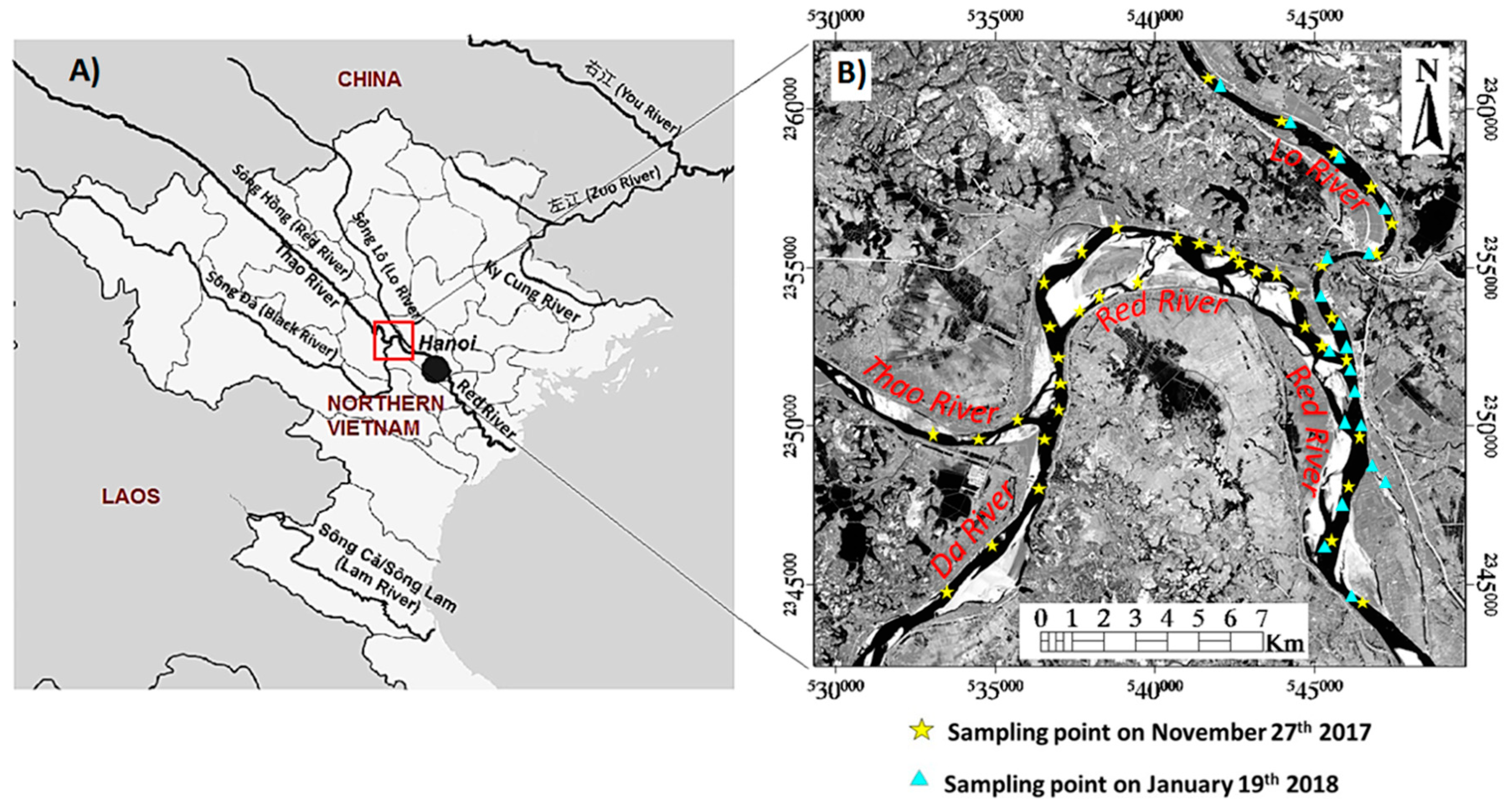
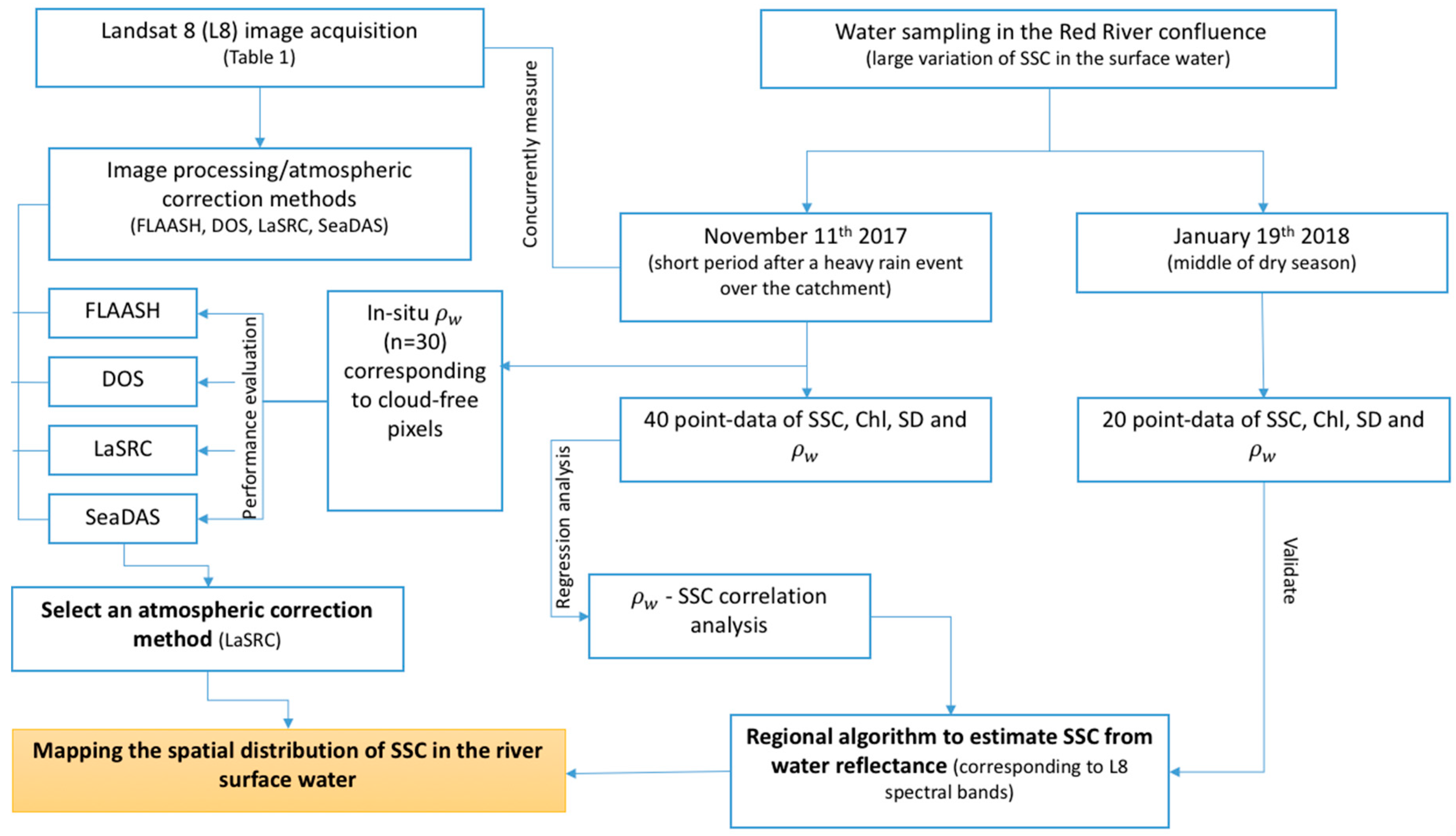
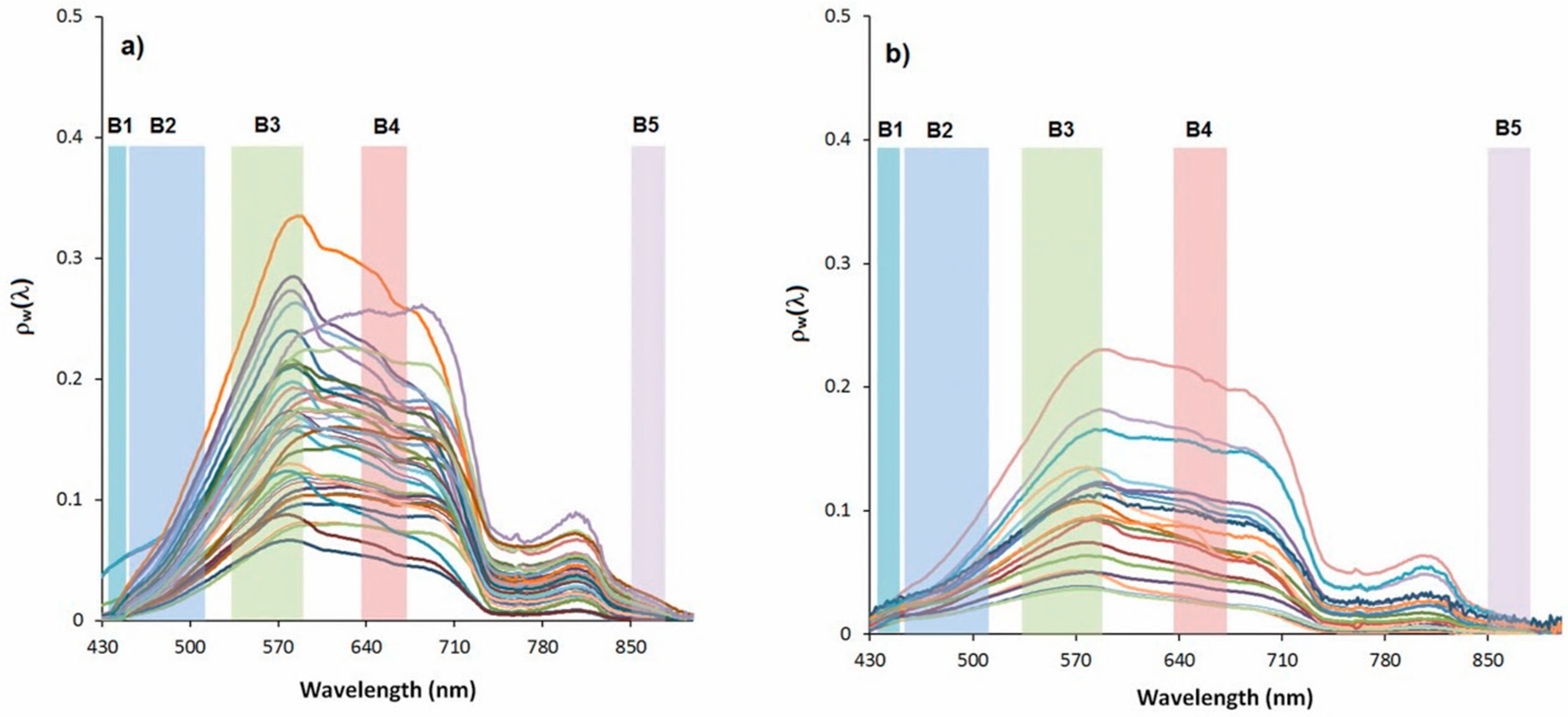
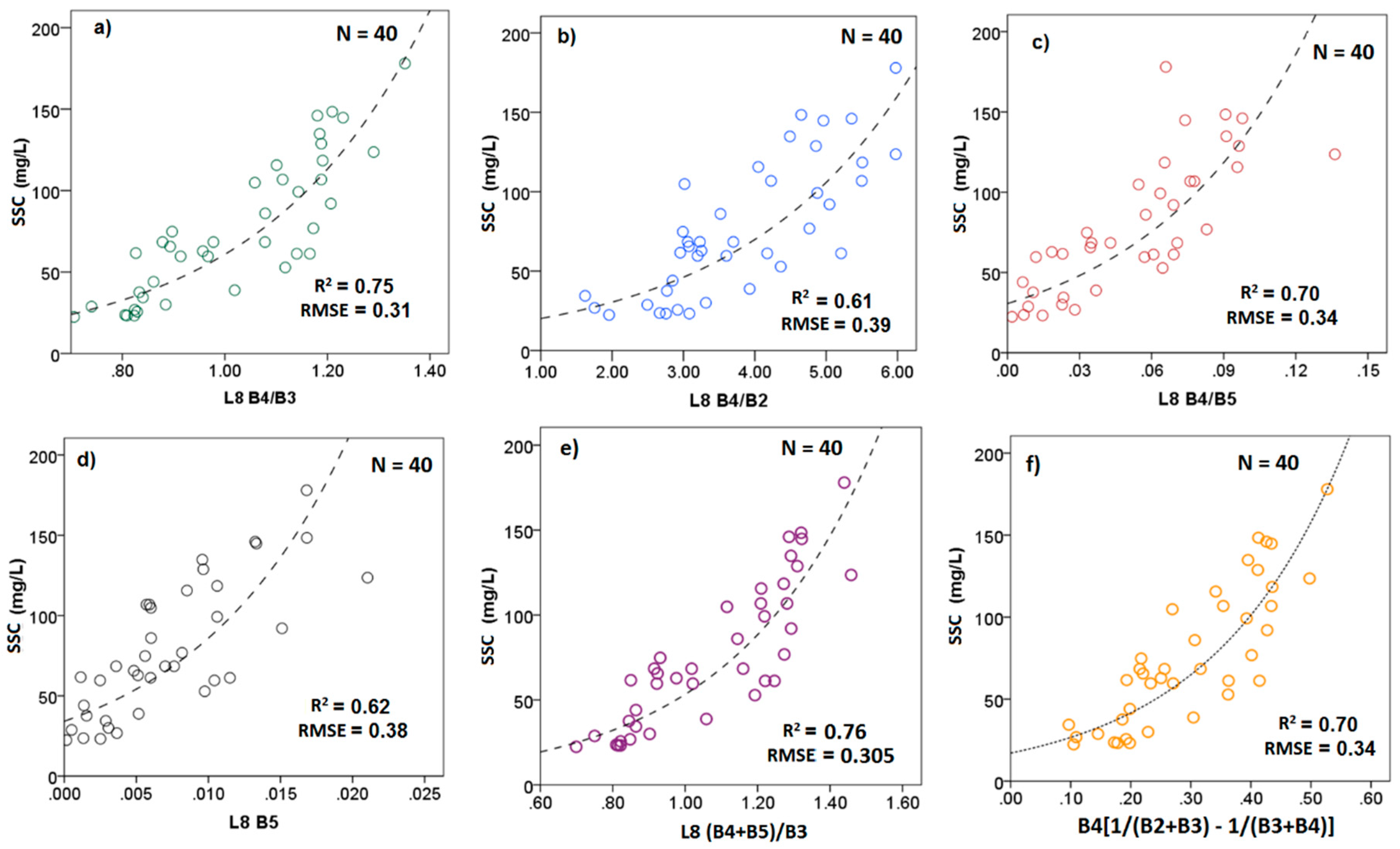
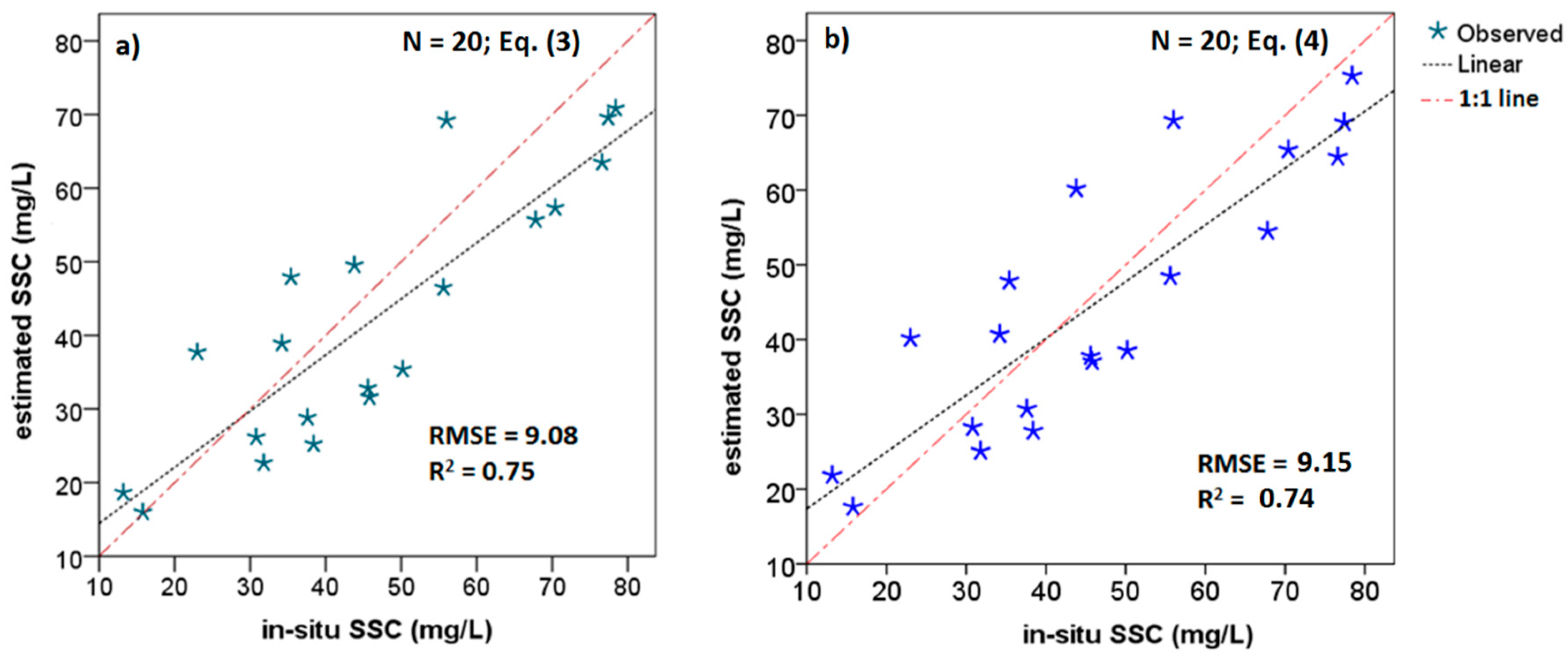
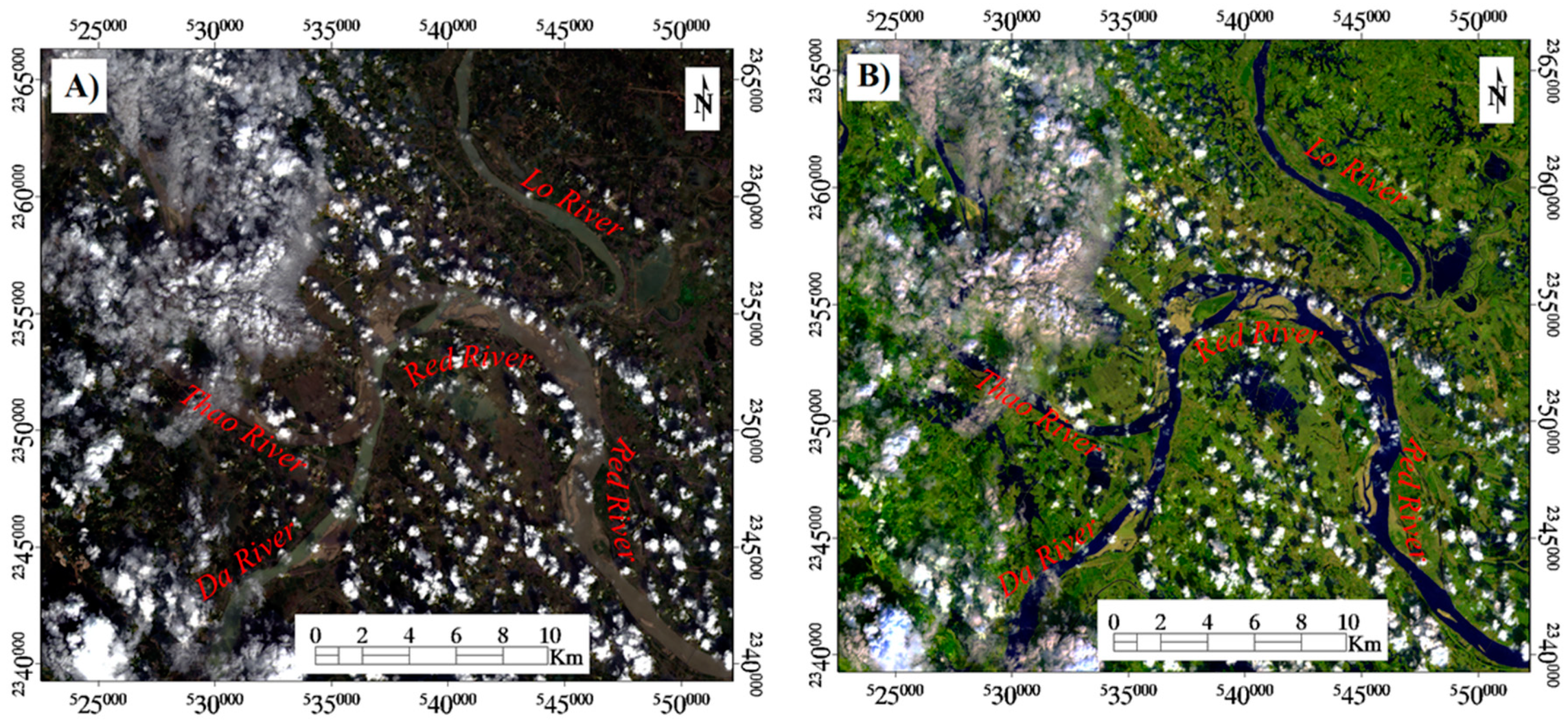
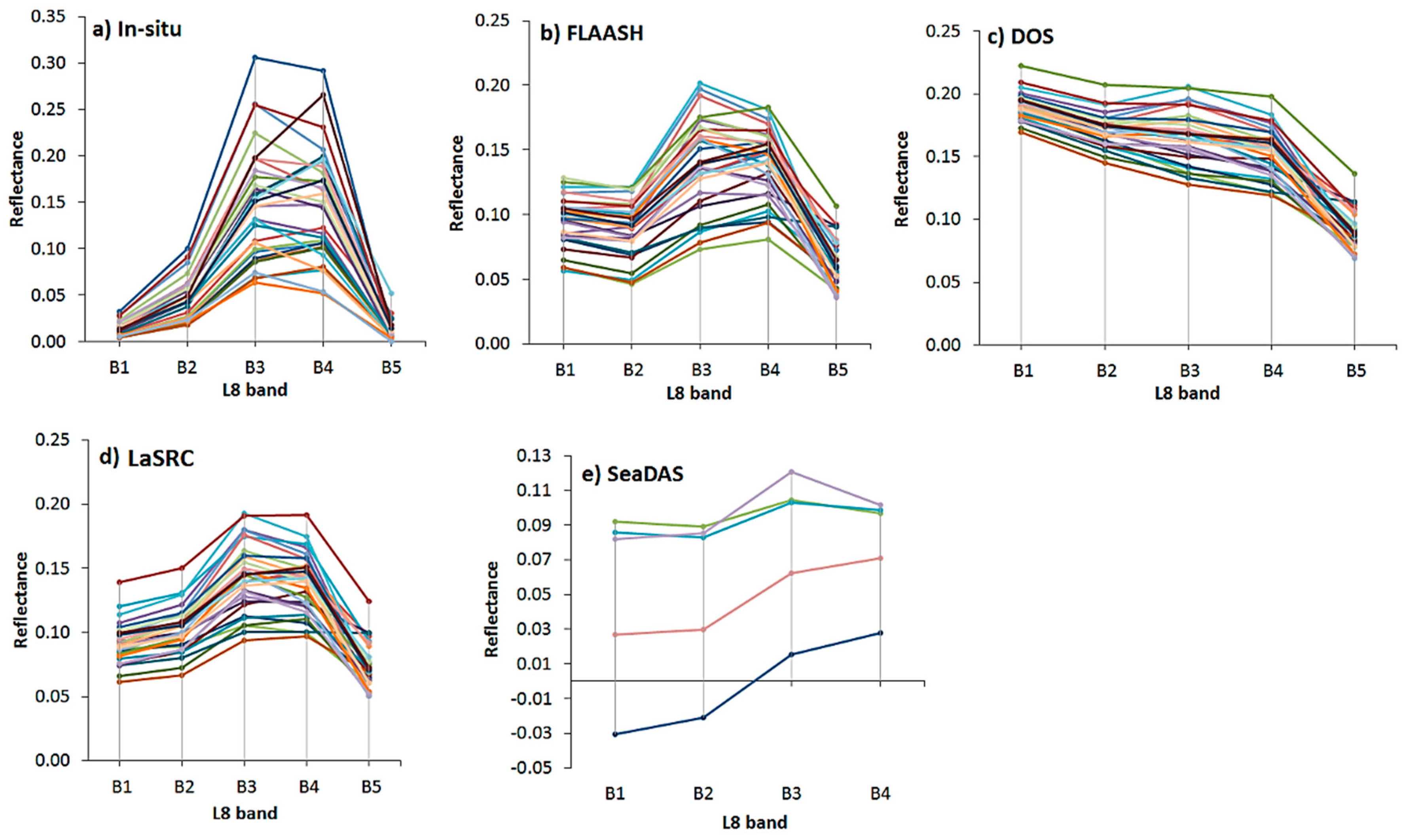
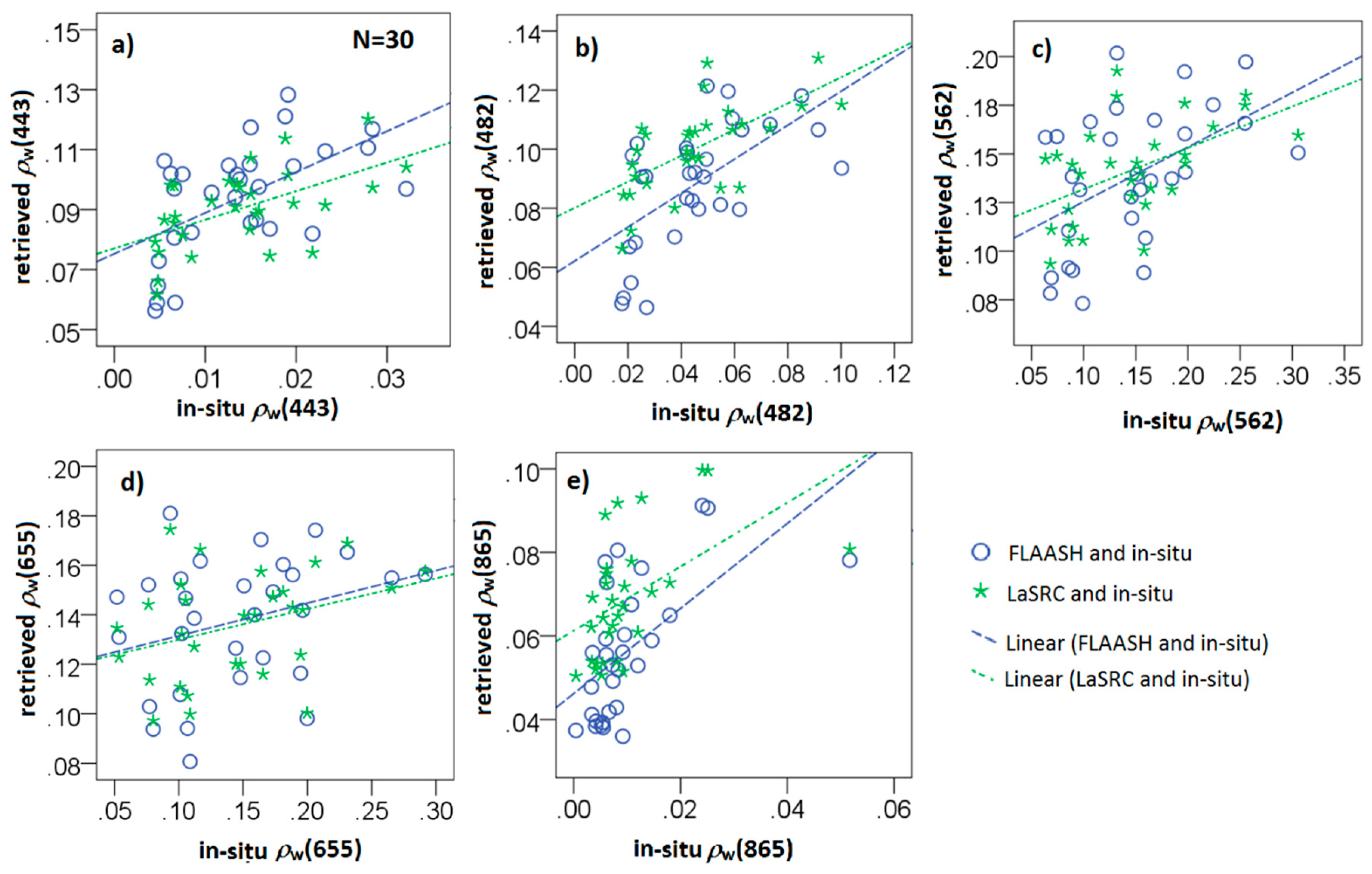
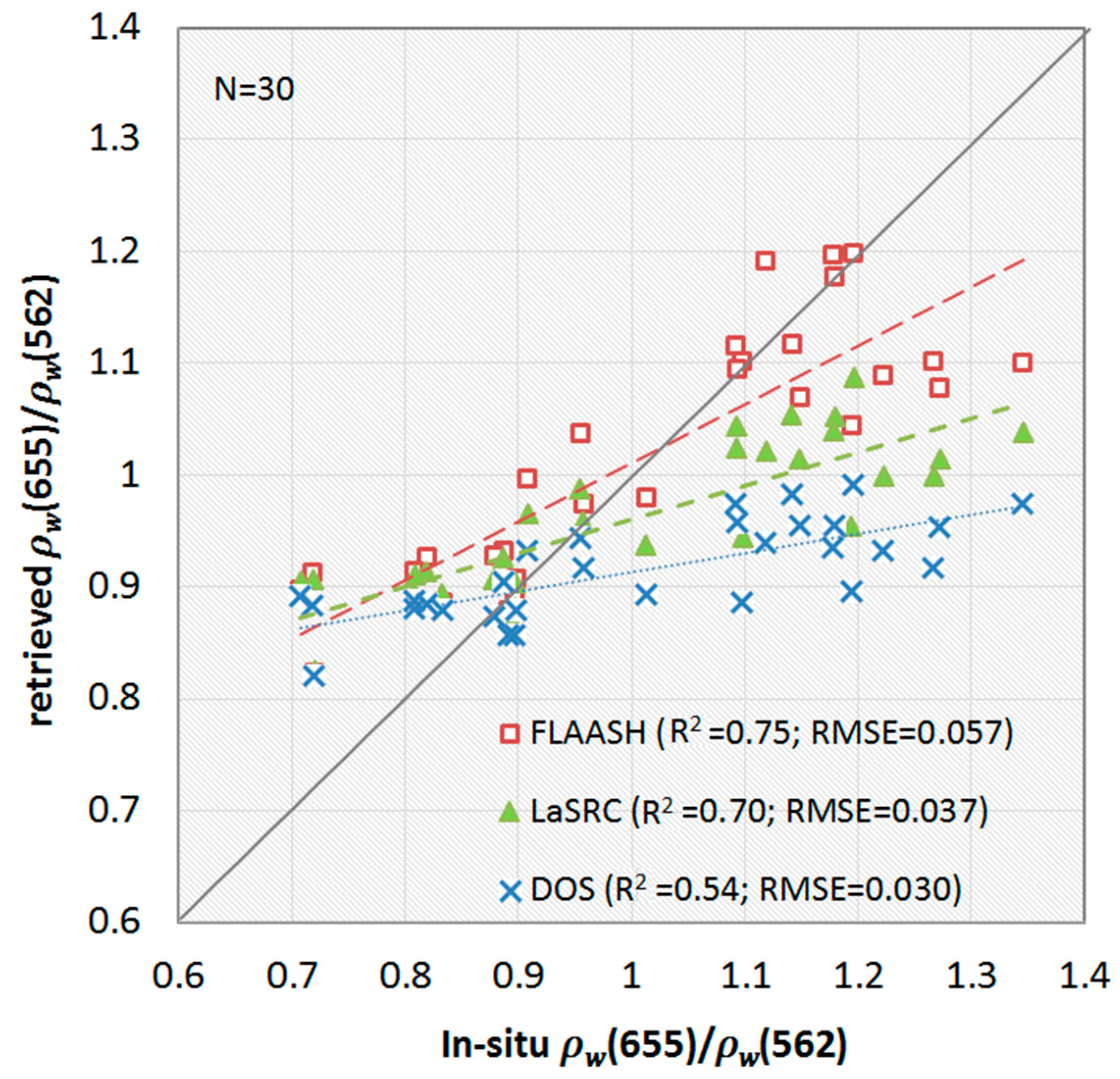
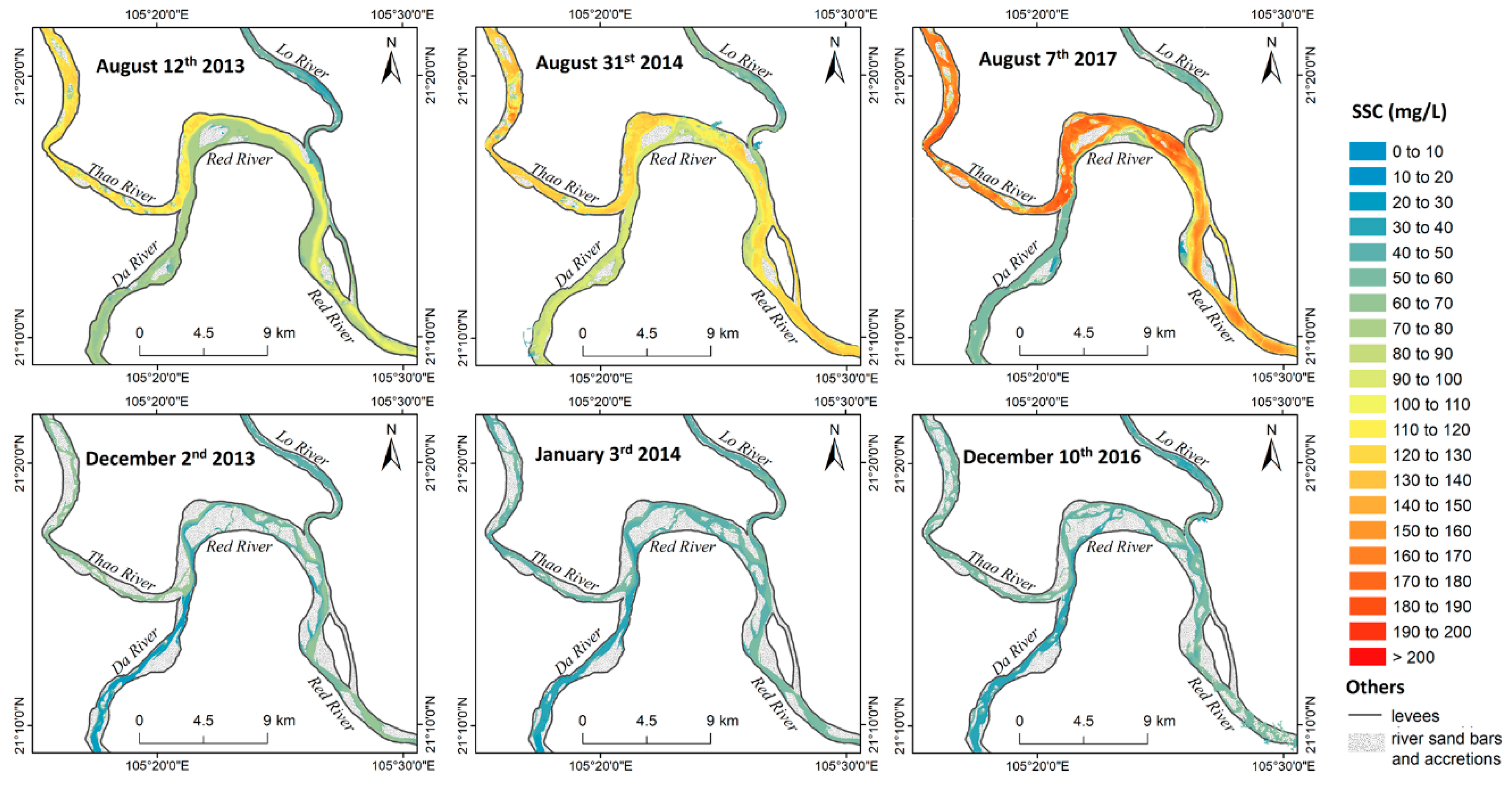
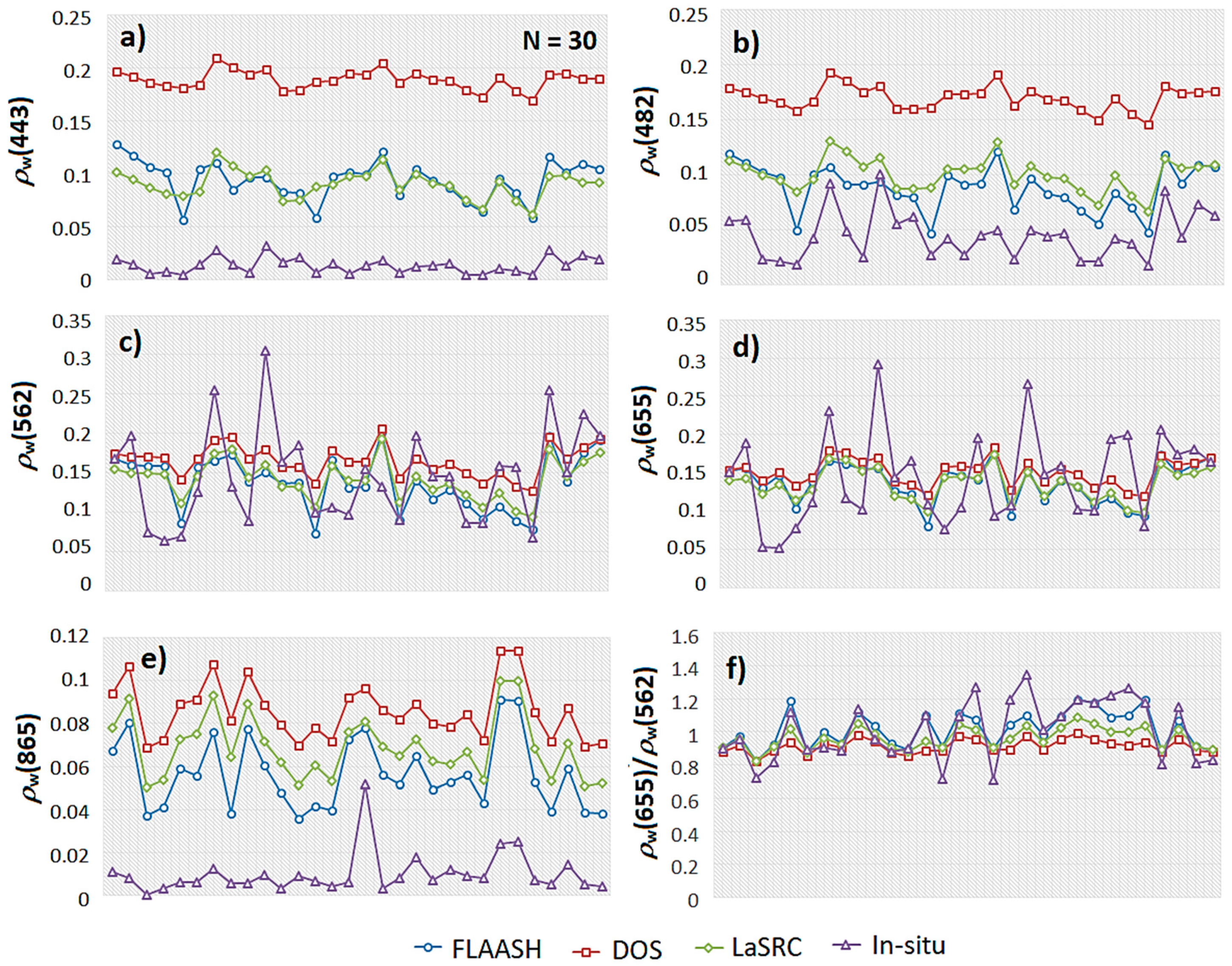
| No. | Scene Identifier | Path/Row | Acquisition Date | Sun Elevation/Azimuth | Cloud Cover |
|---|---|---|---|---|---|
| 1. | LC81270452017315LGN00 | 127/45 | 11 November 2017 | 46.431/152.357 | 45.75 |
| 2. | LC81270452013224LGN01 | 127/45 | 12 August 2013 | 65.906/102.072 | 22.22 |
| 3. | LC81270452014243LGN02 | 127/45 | 31 August 2014 | 63.744/115.977 | 27.82 |
| 4. | LC81270452017219LGN01 | 127/45 | 7 August 2017 | 65.741/98.224 | 34.85 |
| 5. | LC81270452013336LGN01 | 127/45 | 2 December 2013 | 41.969/153.988 | 0.73 |
| 6. | LC81270452014003LGN01 | 127/45 | 3 January 2014 | 39.547/150.417 | 35.41 |
| 7. | LC81270452016345LGN01 | 127/45 | 10 December 2016 | 40.603/153.255 | 30.88 |
| Date | Parameter | N | Minimum | Maximum | Mean | Median | Std. Deviation | RSSC |
|---|---|---|---|---|---|---|---|---|
| 11 November 2017 | SSC (mg/L) | 40 | 22.4 | 178.0 | 75.8 | 75.8 | 42.08 | - |
| SD (cm) | 31 | 15 | 43 | 31.5 | 32.0 | 8.19 | −0.94 | |
| Chl (mg/m3) | 40 | 1.3 | 56.1 | 12.6 | 8.7 | 10.8 | −0.04 | |
| ρw(443) (B1) | 40 | 0.002 | 0.049 | 0.008 | 0.005 | 0.011 | −0.30 | |
| ρw(482) (B2) | 40 | 0.014 | 0.085 | 0.041 | 0.036 | 0.019 | −0.49 | |
| ρw(562) (B3) | 40 | 0.060 | 0.289 | 0.144 | 0.144 | 0.055 | −0.32 | |
| ρw(655) (B4) | 40 | 0.050 | 0.277 | 0.143 | 0.143 | 0.051 | 0.09 | |
| ρw(865) (B5) | 40 | 0.001 | 0.021 | 0.007 | 0.006 | 0.005 | 0.80 | |
| 19 January 2018 | SSC (mg/L) | 20 | 13.2 | 78.4 | 46.4 | 46.4 | 19.98 | - |
| SD (cm) | 20 | 22 | 82 | 39 | 35.0 | 16.07 | −0.77 | |
| Chl (mg/m3) | 20 | 6.7 | 90.3 | 23.2 | 15.4 | 23.3 | −0.68 | |
| ρw(443) (B1) | 20 | 0.008 | 0.025 | 0.016 | 0.015 | 0.005 | 0.50 | |
| ρw(482) (B2) | 20 | 0.016 | 0.067 | 0.035 | 0.035 | 0.013 | 0.41 | |
| ρw(562) (B3) | 20 | 0.035 | 0.201 | 0.093 | 0.093 | 0.044 | 0.42 | |
| ρw(655) (B4) | 20 | 0.025 | 0.209 | 0.083 | 0.075 | 0.050 | 0.58 | |
| ρw(865) (B5) | 20 | 0.000 | 0.013 | 0.005 | 0.004 | 0.004 | 0.65 |
| Methods | Band (nm) | Bias | R2 | RMSE | Slope | y-Intercept |
|---|---|---|---|---|---|---|
| FLAASH | ρw(443) | 0.072 | 0.31 | 0.006 | 0.229 | −0.008 |
| ρw(482) | 0.075 | 0.37 | 0.018 | 0.365 | −0.011 | |
| ρw(562) | 0.129 | 0.23 | 0.032 | 0.028 | 0.097 | |
| ρw(655) | 0.1 | 0.09 | 0.026 | 0.132 | 0.118 | |
| ρw(865) | 0.055 | 0.36 | 0.013 | 1.017 | 0.046 | |
| ρw(655)/ρw(562) | 0.374 | 0.75 | 0.057 | 0.525 | 0.486 | |
| LaSRC | ρw(443) | 0.058 | 0.30 | 0.006 | 0.318 | −0.015 |
| ρw(482) | 0.065 | 0.41 | 0.017 | 0.929 | −0.048 | |
| ρw(562) | 0.099 | 0.27 | 0.022 | 0.213 | 0.111 | |
| ρw(655) | 0.078 | 0.12 | 0.021 | 0.124 | 0.118 | |
| ρw(865) | 0.05 | 0.26 | 0.013 | 0.766 | 0.061 | |
| ρw(655)/ρw(562) | 0.262 | 0.70 | 0.037 | 0.302 | 0.659 | |
| DOS | ρw(443) | 0.04 | 0.31 | 0.008 | 0.650 | 0.180 |
| ρw(482) | 0.047 | 0.41 | 0.009 | 0.324 | 0.155 | |
| ρw(562) | 0.079 | 0.27 | 0.018 | 0.168 | 0.141 | |
| ρw(655) | 0.064 | 0.12 | 0.017 | 0.103 | 0.136 | |
| ρw(865) | 0.045 | 0.26 | 0.012 | 0.698 | 0.079 | |
| ρw(655)/ρw(562) | 0.17 | 0.54 | 0.030 | 0.169 | 0.744 |
© 2018 by the authors. Licensee MDPI, Basel, Switzerland. This article is an open access article distributed under the terms and conditions of the Creative Commons Attribution (CC BY) license (http://creativecommons.org/licenses/by/4.0/).
Share and Cite
Pham, Q.V.; Ha, N.T.T.; Pahlevan, N.; Oanh, L.T.; Nguyen, T.B.; Nguyen, N.T. Using Landsat-8 Images for Quantifying Suspended Sediment Concentration in Red River (Northern Vietnam). Remote Sens. 2018, 10, 1841. https://doi.org/10.3390/rs10111841
Pham QV, Ha NTT, Pahlevan N, Oanh LT, Nguyen TB, Nguyen NT. Using Landsat-8 Images for Quantifying Suspended Sediment Concentration in Red River (Northern Vietnam). Remote Sensing. 2018; 10(11):1841. https://doi.org/10.3390/rs10111841
Chicago/Turabian StylePham, Quang Vinh, Nguyen Thi Thu Ha, Nima Pahlevan, La Thi Oanh, Thanh Binh Nguyen, and Ngoc Thang Nguyen. 2018. "Using Landsat-8 Images for Quantifying Suspended Sediment Concentration in Red River (Northern Vietnam)" Remote Sensing 10, no. 11: 1841. https://doi.org/10.3390/rs10111841
APA StylePham, Q. V., Ha, N. T. T., Pahlevan, N., Oanh, L. T., Nguyen, T. B., & Nguyen, N. T. (2018). Using Landsat-8 Images for Quantifying Suspended Sediment Concentration in Red River (Northern Vietnam). Remote Sensing, 10(11), 1841. https://doi.org/10.3390/rs10111841




